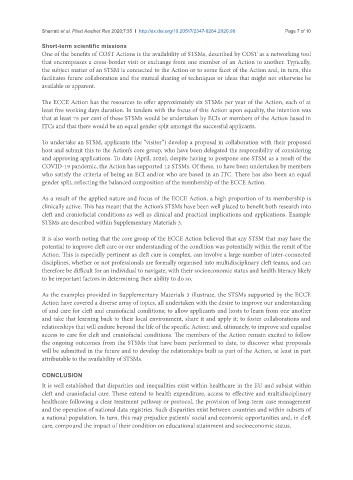Page 387 - Read Online
P. 387
Sharratt et al. Plast Aesthet Res 2020;7:35 I http://dx.doi.org/10.20517/2347-9264.2020.99 Page 7 of 10
Short-term scientific missions
One of the benefits of COST Actions is the availability of STSMs, described by COST as a networking tool
that encompasses a cross-border visit or exchange from one member of an Action to another. Typically,
the subject matter of an STSM is connected to the Action or to some facet of the Action and, in turn, this
facilitates future collaboration and the mutual sharing of techniques or ideas that might not otherwise be
available or apparent.
The ECCE Action has the resources to offer approximately six STSMs per year of the Action, each of at
least five working days duration. In tandem with the focus of this Action upon equality, the intention was
that at least 75 per cent of these STSMs would be undertaken by ECIs or members of the Action based in
ITCs and that there would be an equal gender split amongst the successful applicants.
To undertake an STSM, applicants (the “visitor”) develop a proposal in collaboration with their proposed
host and submit this to the Action’s core group, who have been delegated the responsibility of considering
and approving applications. To date (April, 2020), despite having to postpone one STSM as a result of the
COVID-19 pandemic, the Action has supported 12 STSMs. Of these, 10 have been undertaken by members
who satisfy the criteria of being an ECI and/or who are based in an ITC. There has also been an equal
gender split, reflecting the balanced composition of the membership of the ECCE Action.
As a result of the applied nature and focus of the ECCE Action, a high proportion of its membership is
clinically active. This has meant that the Action’s STSMs have been well placed to benefit both research into
cleft and craniofacial conditions as well as clinical and practical implications and applications. Example
STSMs are described within Supplementary Materials 3.
It is also worth noting that the core group of the ECCE Action believed that any STSM that may have the
potential to improve cleft care or our understanding of the condition was potentially within the remit of the
Action. This is especially pertinent as cleft care is complex, can involve a large number of inter-connected
disciplines, whether or not professionals are formally organised into multidisciplinary cleft teams, and can
therefore be difficult for an individual to navigate, with their socioeconomic status and health literacy likely
to be important factors in determining their ability to do so.
As the examples provided in Supplementary Materials 3 illustrate, the STSMs supported by the ECCE
Action have covered a diverse array of topics, all undertaken with the desire to improve our understanding
of and care for cleft and craniofacial conditions; to allow applicants and hosts to learn from one another
and take that learning back to their local environment, share it and apply it; to foster collaborations and
relationships that will endure beyond the life of the specific Action; and, ultimately, to improve and equalise
access to care for cleft and craniofacial conditions. The members of the Action remain excited to follow
the ongoing outcomes from the STSMs that have been performed to date, to discover what proposals
will be submitted in the future and to develop the relationships built as part of the Action, at least in part
attributable to the availability of STSMs.
CONCLUSION
It is well established that disparities and inequalities exist within healthcare in the EU and subsist within
cleft and craniofacial care. These extend to health expenditure, access to effective and multidisciplinary
healthcare following a clear treatment pathway or protocol, the provision of long-term case management
and the operation of national data registries. Such disparities exist between countries and within subsets of
a national population. In turn, this may prejudice patients’ social and economic opportunities and, in cleft
care, compound the impact of their condition on educational attainment and socioeconomic status.

